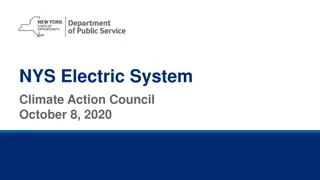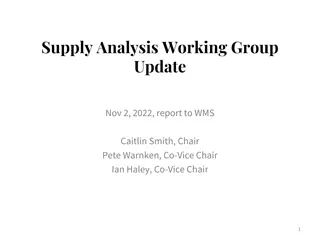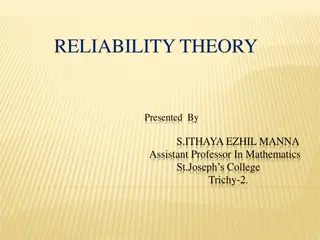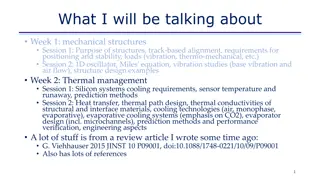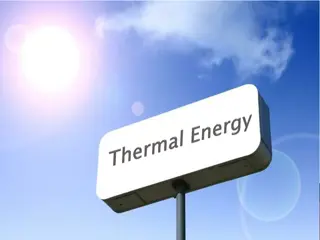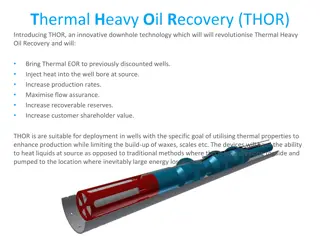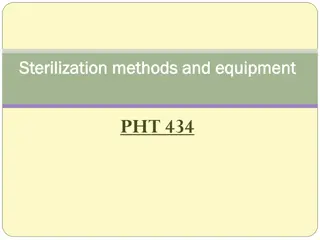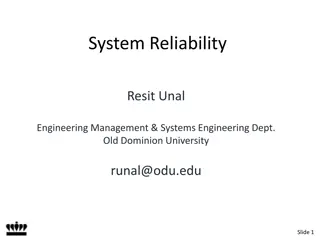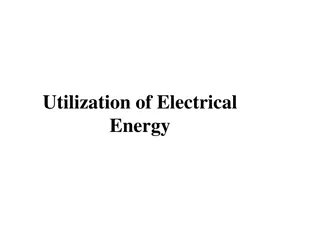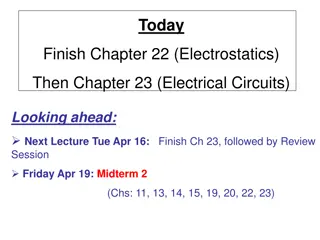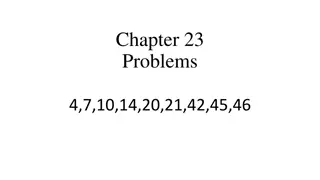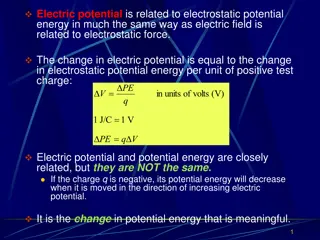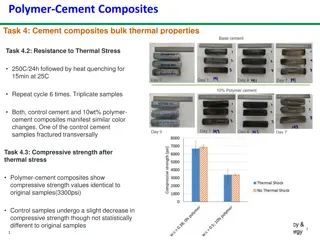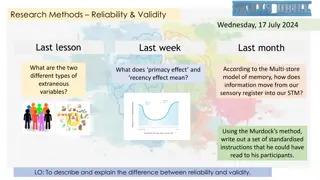Thermal ELCC Study Results for Electric Reliability Council of Texas
Study results on Resource Accreditation, Planning Reserve Margin, and Thermal ELCCs for maintaining grid reliability, considering uncertainty factors like load variability, growth, and generator outages. Exploring UCAP accreditation, outage variability, and interactive effects on fleet-wide thermal resources.
Download Presentation

Please find below an Image/Link to download the presentation.
The content on the website is provided AS IS for your information and personal use only. It may not be sold, licensed, or shared on other websites without obtaining consent from the author. Download presentation by click this link. If you encounter any issues during the download, it is possible that the publisher has removed the file from their server.
E N D
Presentation Transcript
11/9/2022 Thermal ELCC Study Results Prepared for Electric Reliability Council of Texas 1
Resource Accreditation Planning Reserve Margin (PRM) to maintain 0.1 LOLE based on three main uncertainty factors Load variability (weather/customer usage patterns) Load growth uncertainty Generator outage variability Disconnect: Generator performance variability included in PRM while renewable variability addressed via ELCC analysis 2 2
Resource Accreditation and Thermal ELCCs Under a UCAP accreditation market, resource accreditation is converted to a perfectly available capacity equivalent value Thermal resources: UCAP = ICAP * (1-EFORd) Renewable/energy limited resources: Effective Load Carrying Capability (ELCC) In theory, when normalizing for perfectly available capacity, only load uncertainty drives the UCAP RM 3 3
Resource Accreditation and Thermal ELCCs However, UCAP accreditation may not be a good proxy for perfectly available capacity when accounting for fleet wide interactions of thermal resources Sum of all individual thermal resource UCAP values may be greater than the actual fleet wide contribution towards reliability (i.e., the thermal resource ELCC) May or may not affect PRM Key fleet wide interactive outage effect categories include: Outage variability Common mode failures Weather dependent outages Fuel availability outages 4 4
Outage Variability What level of reserves are needed to cover the impact of outages? UCAP accounting using EFORd presumes only average outages need to be addressed. 5 5
Outage Variability Outage variability is generally hidden in the PRM assessment. This issue would not be expected to affect PRM, only resource accreditation 6 6
ELCC Matrix Battery Penetration (GW) Thermal Penetration (GW) 0 Fuel ELCC Scenario Solar Penetration (GW) Wind Penetration (GW) Cold Weather Outage Assumption Availability Assumption 1 2 3 4 5 6 7 8 9 2024 Portfolio 2024 Portfolio 2024 Portfolio Exclude 2021 2024 Portfolio 0 0 0 0 2024 Portfolio 2024 Portfolio 2024 Portfolio Exclude 2011 and 2021 Exclude 2021 2024 Portfolio 0 0 0 0 2024 Portfolio 2024 Portfolio 2024 Portfolio Include 2011 and 2021 2024 Portfolio 0 0 0 10 11 12 13 14 15 16 17 18 0 2024 Portfolio 2024 Portfolio 2024 Portfolio Exclude 2021 2024 Portfolio 0 0 0 0 2024 Portfolio 2024 Portfolio 2024 Portfolio Exclude 2011 and 2021 Include 2021 2024 Portfolio 0 0 0 0 2024 Portfolio 2024 Portfolio 2024 Portfolio Include 2011 and 2021 2024 Portfolio 0 0 0 7 7
ERCOT Resource Mix as Modeled within SERVM for 2024 Capacity (MW) 900 163 13,568 0 31,132 6,085 922 10,717 475 1,591 4,973 200 1,500 4,262 2,800 34,951 7,620 0 5,900 29,233 4,903 156,563 Unit Type 4CP BIOMASS COAL ERS GAS-CC GAS-GT GAS-IC GAS-ST HYDRO LRs NUCLEAR PBPC PRD PUNS Reserve Shed SOLAR STORAGE TDSP WIND-C WIND-O WIND-P Total 8 8
Conventional Generator Outages Model individual unit outages stochastically, including: Full Outages: mean time to fail, mean time to repair Partial Outages: derate percentage, mean time to fail, mean time to repair Startup Failure: rate Maintenance Outages: average outage rate with random occurrence and limited scheduling flexibility Planned Outages: average outage rate with known occurrence and substantial scheduling flexibility in fleet Distributions of outage parameters created from: Historical GADS data provided by ERCOT for most of the fleet (2018-2021 excluding Yuri events) Units without historical GADS data are linked to units with data by unit class and size Batteries were modeled with a 5% forced outage rate 9 9
Cold Weather and Fuel Availability Outages Additional forced outage probabilities were modeled for temperatures below 20 F Forced outages from 2018-2021 as a function of temperature were analyzed while excluding winter storm Uri. A trend was added to the graph below 20 F and extrapolated to 0 F A linear probability was assigned with an increased incremental hourly forced outage probability The base extrapolated value of 5,000 MW was not as extreme as the 2011 outages (14.7 GW forced offline when system temperatures were roughly 14 F) The impacts of the new weatherization requirements are not being considered in the temperature outage correlation modeling https://www.ferc.gov/sites/default/files/2020-05/ReportontheSouthwestColdWeatherEventfromFebruary2011 Report.pdf 10 10
Thermal ELCC Results Winter UCAP/ Winter CDR Rating (%) 94.6% 94.9% 94.9% 95.0% 95.1% 95.1% 96.1% 96.3% 96.3% 96.6% 96.9% 97.1% Summer UCAP/ Summer CDR Rating (%) 93.9% 93.9% 93.9% 94.0% 94.0% 94.0% 94.4% 94.4% 94.4% 94.4% 94.4% 94.4% Winter ELCC (%) Summer ELCC (%) Battery Solar Wind Thermal Cold Weather Fuel 0 0 0 0 0 0 0 0 0 0 0 0 0 0 0 0 0 0 2024 2024 2024 2024 2024 2024 2024 2024 2024 2024 2024 2024 Base Base 2011 2011 None 89.6% 87.5% 87.5% 83.5% 78.0% 67.7% 89.9% 87.9% 87.9% 83.4% 78.9% 69.3% 89.8% 89.8% 89.8% 89.5% 89.6% 89.6% 90.8% 90.7% 90.7% 90.7% 90.8% 90.8% Include Fuel None Include Fuel None 2011 and 2021 2011 and 2021 Include Fuel Base Base 2011 2011 2011 and 2021 2011 and 2021 Include Fuel 2024 2024 2024 2024 2024 2024 2024 2024 2024 2024 2024 2024 2024 2024 2024 2024 2024 2024 None Include Fuel None Include Fuel None 12 12
Appendix 13
ERCOT Resource Mix as Modeled within SERVM for 2024 Capacity (MW) 900 163 13,568 0 31,132 6,085 922 10,717 475 1,591 4,973 200 1,500 4,262 2,800 34,951 7,620 0 5,900 29,233 4,903 156,563 Unit Type 4CP BIOMASS COAL ERS GAS-CC GAS-GT GAS-IC GAS-ST HYDRO LRs NUCLEAR PBPC PRD PUNS Reserve Shed SOLAR STORAGE TDSP WIND-C WIND-O WIND-P Total 14 14
Overview Strategic Energy and Risk Valuation Model (SERVM) is a probabilistic multi-area reliability and economic modeling tool, representing: Demand in ERCOT and external regions Generation with randomized outages Demand response of several types with differing availability and emergency or economic triggers Emergency procedures that ERCOT triggers in shortage conditions Monte Carlo simulation of 20,500 different annual hourly-sequential simulations at each reserve margin Primary outputs are reported at each reserve margin, including: Reliability metrics such as LOLE Economic costs such as production costs, DR curtailment costs, and emergency intervention costs Market results including prices and energy margins 20,500 Simulations per Reserve Margin 41 5 100 Weather Years Forecast Error Points Unit Outage Draws 15 15
Load Modeling Load Forecast Uncertainty and Forward Period Non-Weather Forecast Error With Increasing Forward Period Non-weather load forecast error increases with forward period: Assume electric load growth increases at 40% the rate of GDP growth (approximately consistent with ERCOT forecast and national average) Economic forecast uncertainty increases with forward period, consistent with uncertainty distribution around 28 years of CBO economic forecasts Modeling approach: Assume resource decisions and reserve margin must be locked in 2 years forward 2-Year Forward LFE Discrete LFE Error Points Modeled -4% -2% 0% 2% 4% 2.3% 23.0% 49.4% 23.0% 2.3% 17 17
Generation Resources Fuel Prices ERCOT Fuel Forecast Coal Fuel Price ($/MMBtu) Gas Fuel Price ($/MMBtu) Diesel Fuel Price ($/MMBtu) Study Year 2024 2.52 3.38 11.14 NG Price Source: https://www.cmegroup.com/markets/energy/natural-gas/natural-gas.quotes.html 18 18
Generation Resources Conventional Generation Outages Model individual unit outages stochastically, including: Full Outages: mean time to fail, mean time to repair Partial Outages: derate percentage, mean time to fail, mean time to repair Startup Failure: rate Maintenance Outages: average outage rate with random occurrence and limited scheduling flexibility Planned Outages: average outage rate with known occurrence and substantial scheduling flexibility in fleet Distributions of outage parameters created from: Historical GADS data provided by ERCOT for most of the fleet (2018-2021 excluding Yuri events) Units without historical GADS data are linked to units with data by unit class and size Batteries were modeled with a 5% forced outage rate 19 19
Generation Resources Conventional Generation Outages 20 20
Generation Resources Conventional Generation Outages Cold Weather Additional probabilities were modeled for forced outages at temperatures below 20 F A linear probability was assigned with an hourly incremental forced outage probability of 1.07% at 0 F down to 0% at 20 F leading to an average of ~9,000 total MW being forced offline at 0 F The impacts of the new weatherization requirements are not being considered in the temperature outage correlation modeling 21 21
Generation Resources Private Use Networks Net Gen Supply Curve Modeled as probabilistic quantity of net output, with 10 different possible quantities at any given load level Expected quantity increases with load level, based on realized net generation levels at normalized load levels in 2019 West modeled as a 9 MW generator 22 22
Generation Resources Wind and Solar Wind 42 years of hourly local wind shapes provided by ERCOT from AWS True Power Aggregated operational local curves to system-wide 39.3% average capacity factor 30% Wind-P / 57% Wind-C / 20% Wind-O capacity credit (consistent with CDR) Solar Photovoltaic 42 years of hourly solar county-specific shapes provided by ERCOT Aggregated operational local curves to system-wide 26.0% average capacity factor 81% capacity credit (consistent with CDR) Sources and Notes: Weighted average of 42 years hourly wind profiles provided by ERCOT 23 23
Generation Resources Wind and Solar 24 24
Generation Resources Hydroelectric 557.4 MW nameplate Characterized resources based on: 8 years of hourly data from ERCOT 41 years of monthly data from EIA 923 Hydro resources modeled with different parameters each month: Monthly total energy output Daily maximum output Daily minimum output Monthly maximum output Energy is primarily scheduled to shave peak loads consistent with historical operations Unscheduled hydro capacity (monthly capacity minus output) counts toward RRS and ORDC x-axis 25 25
Generation Resources Hydroelectric, continued Historical Hydro Energy to Daily Max Dispatch Relationship Curve fit equation used to determine input for each month into SERVM for daily maximum output Similar curve developed for daily minimum dispatch Historical Hydro Energy to Capacity Relationship Curve fit equation used to determine maximum capacity for each month Emergency capacity of 49.25 MW modeled for drought conditions and 116.15 MW modeled for all other months 26 26
Generation Resources Storage The following assumptions were made for the storage resources: Economic Commitment and Dispatch Charges from the Grid Any Unit Without Provided Charging Capability was Assumed to Have a 1.5 Hour Storage Capability (Assumed to be all 2 Hour for the ELCC Study) 85% Round Trip Efficiency 5% Outage Rate 27 27
Generation Resources Inclusion and Exclusion of Resources In general, we use the 2022 May CDR as the authoritative source, but use the following assumptions for including certain resource types: Switchable Units: include as internal resources, with the units that are committed off-system excluded from our model New Units: include starting in the CDR-specified year Retirements: exclude starting in the CDR-specified year Permanent Mothballs: exclude from model Inactive Planned: exclude from model 28 28
Demand-Side Resources Cost and Modeling of Demand Resources Marginal Curtailment Cost Reserve Margin Accounting Resource Type Quantity Modeling Approach Adjustments to ERCOT Load Shapes (MW) TDSP Programs None Energy Efficiency 3,262 Not explicitly modeled n/a (ERCOT load shapes already reduced for TDSP EE Programs) None (ERCOT load shapes estimated assuming no LM curtailments) Load reduction Load Management 307 Emergency trigger at EEA Level 1 $2,543 Load reduction Emergency Response Services (ERS) 30-Minute ERS 890 Emergency trigger at EEA Level 1 $1,721 Load reduction None (ERCOT load shapes estimated assuming no ERS curtailments) 10-Minute ERS 35 Emergency trigger at EEA Level 2 $2,543 Load reduction Load Resources (LRs) Economically dispatch for RRS (most hours) or energy (few peak hours). Emergency deployment at EEA Level 2 None 1,591 Non-Controllable LRs $2,543 (ERCOT load shapes estimated assuming negligible LR curtailments) Load reduction 0 Currently no controllable LRs modeled in ERCOT Controllable LR n/a Voluntary Self-Curtailment Load shapes grossed up for projected response and corresponding response modeled on the resource side None. Already excluded from reported peak load 1,700 4 CP Reductions n/a None Load shapes explicitly grossed up for expected response. Economic self- curtailment modeled on resource side $500 - $5,000 /MWh None. Already excluded from reported peak load Variable Price-Responsive Demand None Note: The marginal cost of the emergency DR is given by the prices on the dark blue curve corresponding to the reserve levels at the EEAs at which emergency DR is triggered. That assumes the blue curve reflects actual costs (with the red curve shifted right to boost resource adequacy) and that actions are taken at an economically rational point. Prices are set according to the red curve. We observed that modeled prices will tend to cluster around the EEA trigger points on the red curve since a range of net loads and corresponding emergency DR deployments will stay on that shelf. 29 29
Demand-Side Resources Emergency Response Service (ERS) Contract Period Quantity 10-Min NWS (MW) 30-Min NWS (MW) 30-Min WS (MW) Total (MW) June - September TP1: Weekdays HE 6 AM - 9 AM TP2: Weekdays HE 10 AM - 1 PM TP3: Weekdays HE 2 PM - 4 PM TP4: Weekdays HE 5 PM - 7 PM TP5: Weekdays HE 8 PM - 10 PM TP6: Weekend and Holidays HE 6 AM - 9 AM TP7: Weekend and Holidays HE 4 PM - 9 PM TP8: All Other Hours October - November TP1: Weekdays HE 6 AM - 9 AM TP2: Weekdays HE 10 AM - 1 PM TP3: Weekdays HE 2 PM - 4 PM TP4: Weekdays HE 5 PM - 7 PM TP5: Weekdays HE 8 PM - 10 PM TP6: Weekend and Holidays HE 6 AM - 9 AM TP7: Weekend and Holidays HE 4 PM - 9 PM TP8: All Other Hours December - March TP1: Weekdays HE 6 AM - 9 AM TP2: Weekdays HE 10 AM - 1 PM TP3: Weekdays HE 2 PM - 4 PM TP4: Weekdays HE 5 PM - 7 PM TP5: Weekdays HE 8 PM - 10 PM TP6: Weekend and Holidays HE 6 AM - 9 AM TP7: Weekend and Holidays HE 4 PM - 9 PM TP8: All Other Hours April - May TP1: Weekdays HE 6 AM - 9 AM TP2: Weekdays HE 10 AM - 1 PM TP3: Weekdays HE 2 PM - 4 PM TP4: Weekdays HE 5 PM - 7 PM TP5: Weekdays HE 8 PM - 10 PM TP6: Weekend and Holidays HE 6 AM - 9 AM TP7: Weekend and Holidays HE 4 PM - 9 PM TP8: All Other Hours 47.1 46.8 38.3 35.3 42.4 45.8 40.8 44.2 991.3 1,154.3 1,040.1 847.9 985.7 823.4 818.8 863.5 - - 1,038.4 1,201.1 1,120.2 925.0 1,028.2 869.2 859.6 907.6 41.8 41.8 - - - - 105.9 95.1 96.3 107.6 105.6 103.2 105.2 57.6 1,073.5 1,032.4 1,038.0 1,109.1 1,089.0 956.8 971.7 900.1 - - - - - - - - 1,179.4 1,127.5 1,134.4 1,216.8 1,194.6 1,060.0 1,077.0 957.8 97.8 98.5 99.8 97.4 96.7 32.4 33.8 92.2 994.7 1,004.1 1,010.9 1,014.2 996.5 764.0 802.6 887.8 5.5 - - 5.5 5.5 5.5 - - 1,098.0 1,102.6 1,110.7 1,117.2 1,098.8 802.0 836.4 979.9 386.3 345.7 342.5 375.4 378.1 332.5 327.0 336.5 736.3 771.5 770.6 752.5 733.9 530.6 536.5 643.3 2.2 - 19.9 27.7 19.9 1,124.7 1,117.3 1,133.1 1,155.6 1,132.0 863.1 885.6 979.9 - 22.2 - Sources and Notes: Total available ERS MW for 2024 June-Sept. TP4 provided by ERCOT staff. ERS 10-min and 30-min MW for other contract periods scaled proportionally to the 2022 May CDR summer quantity (925 MW), based on availability in 2022. Assume an 8-hour call limit applies to both product types, resources not callable outside contracted hours. 30 30
Demand-Side Resources Non-Controllable Load Resources (LRs) Non-controllable LR magnitude varies by season and time of day Dispatched according to emergency operating procedures Dispatches during EEA 2 events Available reserves at 1,750 MW when dispatched Note: CDR quotes 1,591 MW LRS for 2024 31 31
Demand-Side Resources Price-Responsive Demand (PRD) 32 32
Demand-Side Resources Price-Responsive Demand (PRD) 33 33
Demand-Side Resources 4CP 34 34
System Summary Intertie Availability We model total intertie capacity in line with ERCOT transmission documents Intertie availability at summer peak is based on historical availability consistent with the May 2022 CDR The SPP-Entergy interface availability similarly modeled using a point forecast Even if transmission is available, ERCOT may not be able to import in emergency if the external region is peaking at the same time SPP 5,180 MW 820 MW Entergy (MISO) ERCOT 400 MW Mexico (Coahuila, Nuevo Leon, & Tamaulipas) Sources: ERCOT Ties: http://www.ercot.com/content/wcm/key_documents_lists/90055/ ERCOT_DC_Tie_Operations_Document.docx SPP-Entergy: www.oasis.oati.com/SWPP/SWPPdocs/Interface_Values.xls 35 35
Scarcity Conditions Emergency Procedures and Marginal Costs Emergency Level Marginal Resource Amount of Resource (MW) Trigger Price Marginal System Cost n/a Generation Variable Price Approximately $20 - $250 Same n/a Imports Variable Price Approximately $20-$250 Up to $1,000 during load shed Same n/a Non-Spin Shortage 1,500 ORDC x-axis = 3,000 MW $5,000 (from ORDC)* $1,313* n/a Price-Responsive Demand Variable Price $500 - $5,000 Same n/a PBPC 200 Price $1,000 - $5,000 Same EEA 1 30-Minute ERS 890** Spin ORDC x-axis = 2,300 MW $5,000 (from ORDC) $1,721 EEA1 Spin Shortage A 550 Spin ORDC x-axis = 2,300 MW $5,000 (from ORDC)* $2,079* EEA 2 TDSP Load Curtailments 307 Spin ORDC x-axis = 1,750 MW $5,000 (from ORDC) $2,543 EEA 2 Load Resources in RRS 1,591*** Spin ORDC x-axis = 1,750 MW $5,000 (from ORDC) $2,543 EEA 2 10-Minute ERS 35** Spin ORDC x-axis = 1,750 MW $5,000 (from ORDC) $2,543 EEA3 Spin Shortage B 750 Spin ORDC x-axis =1,750 MW $5,000 (from ORDC)* $3,115* EEA 3 Load Shed Variable Spin ORDC x-axis = 1,000 MW VOLL = $5,000 Same *: Price reflects the average price between the upper and lower level of each resource **: 35 10NWS + 848 30NWS + 42 30WS = 925 total ERS (May 2022 CDR Value for 2023). Both NWS and WS are included in the 30-Minute ERS ***: 60% of RRS 36 36
Scarcity Conditions Power Balance Penalty Curve Implementation Power Balance Penalty Curve Using PBPC curve as currently set by ERCOT; no expectation for the curve to change in upcoming years. Treat as a Reg Up shortage when called (can set price) Incur marginal system cost equal prices implied by PBPC Model only first 200 MW Highest price capped at LCAP + $1 if Peaker Net Margin (PNM) threshold is exceeded Note: Since we model PBPC as a 200 MW resource (when none exists), we need to recognize that dispatching the PBPC depletes actual regulation reserves more than our accounting implies. So the model has to shed load at 1,200 MW apparent reserves instead of 1,000. And the x-axis for determining ORDC prices is given by reserves + any PBPC deployment. Sources and Notes: https://www.ercot.com/files/docs/2021/12/14/037OBDRR_01_Power_Balance_Pe nalty_Updates_to_%20Align_with_PUCT_Approved_High_System_Wide_Offe r_Ca.docx 37 37
Scarcity Conditions Operating Reserve Demand Curve Implementation Operating Reserve Demand Curves Price-setting based on curve where X = 3,000 MW; marginal system cost assumes load shed at X = 1,000 MW Simplifications: Assume PRC, Spin, and ORDC x-axis are all self-consistent Do not scale ORDC curves each hour, instead calculate as if marginal energy were fixed at the emergency gen dispatch price of $1,721/MWh Assume non-spin is depleted before spin (i.e., 1-to-1 correspondence between the x- axes of Spin and Non-Spin ORDC curves) Day-ahead commitment of spin is equal to the minimum of: (a) ERCOT requirement, and (b) reasonable min ORDC spin price of $3/MWh (i.e., allow self-commitment to prevent very high prices during long conditions) 38 38
Scarcity Conditions Reserve Requirements Reserves Reserves Requirements Day-ahead commitments to meet ERCOT Reg Up, Reg Down, and RRS requirements (NSRS assumed non- binding) ERCOT Day-Ahead Procurements Regulation Up (MW) (MW) Season and Hours of Day Regulation Down RRS 10 min (MW) NSRS 30 min (MW) Winter 1-2 and 23-24 3-6 7-10 11-14 15-18 19-22 Spring 1-2 and 23-24 3-6 7-10 11-14 15-18 19-22 Summer 1-2 and 23-24 3-6 7-10 11-14 15-18 19-22 Fall 1-2 and 23-24 3-6 202 342 435 375 528 256 311 252 398 428 350 324 3,042 3,028 2,937 2,926 2,939 2,939 3,486 3,519 3,997 3,882 4,601 3,926 Shortages relative to requirement only occur when insufficient resources exist Self-Commitments 230 296 431 486 487 404 403 248 386 435 424 415 3,083 3,107 3,013 2,941 2,906 2,906 3,819 4,038 4,416 4,282 4,338 3,829 Also model economic self- commitments if ORDC spin axis price is very high (still refining approach) 169 250 436 588 410 273 462 218 252 266 364 452 2,555 2,634 2,522 2,350 2,800 2,800 3,913 3,300 4,053 4,460 3,374 3,962 Estimate as quantity of online capacity needed to bring total daily ORDC spin payments down to historical RRS price levels in non-peak conditions 184 269 367 212 2,964 3,006 3,528 3,034 7-10 398 300 2,856 3,753 11-14 15-18 19-22 466 456 252 356 344 399 2,768 2,845 2,861 4,165 3,989 3,742 SERVM will commit at least this quantity unless insufficient supply exists 39 39


